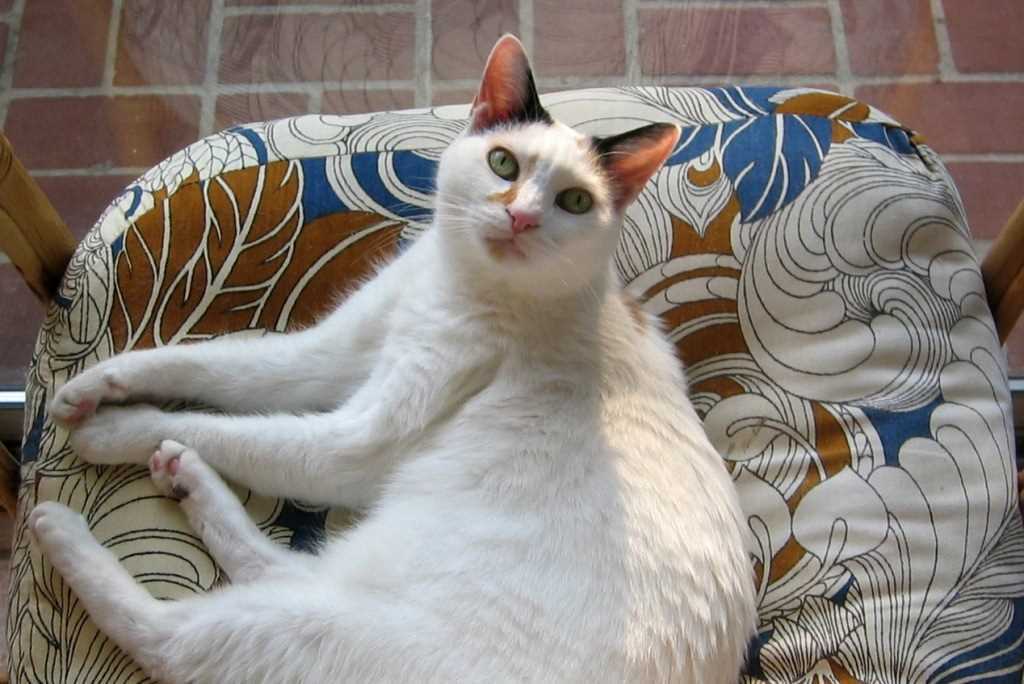The Japanese Bobtail Cat comes from a very ancient natural selection. It is said that its origins are Chinese, but it is widespread especially in Japan from which it takes its name, while Bobtail means that it has no tail or almost no tail. In Japan they are considered as good luck charms, and to attract good people, that is why in many stores in Japan there is a statuette representing this cat with a raised paw as a sign of greeting. These figurines are called Maneki-neko and are also depicted in many greeting cards as a symbol of good luck and prosperity.
Widespread in Japan, however, is almost unknown in the rest of the world. Until 1600 this cat was exclusively property of the Emperor and only he could keep it. They lived inside the temples and in the royal families, but around that year the emperor was asked to free them to protect the silkworm plantations, which at that time were particularly threatened by rodents, and so they spread throughout the country becoming good domestic cats in many families.
In America some specimens arrived at the end of the 60’s and in Europe around 1980.
Character of the Japanese Bobtail Cat
The Japanese Bobtail Cat has a very sweet and affectionate character, very intelligent and learns to answer to its name, to bring back objects and also to go out with the leash. They love being around people and playing, so much so that they would never stop. They are agile jumpers, so in the house it is good to provide them with places where they can jump as they please They are very curious and their intelligence leads them to be able to open doors and refrigerators and even doors, which can lead to some escape outside, although it is not very frequent as this cat takes possession of the environment in which it is located and takes possession of all its parts. It is a cat that does not like solitude, if left alone it gets bored and tends to have fun with what it finds, sometimes causing trouble.
It is very affectionate with its family members, but it is not a cat that loves to spend a lot of time on its owner’s lap, it prefers to sit next to him on the sofa or even on the bed. It is known to be a great talker and tries to make itself understood by modulating its voice in delicate vocalizations.
It is suitable for children because it needs to play a lot, in the same way it is not suitable for the elderly because it is not really a living room cat. With strangers it is not shy, on the contrary it approaches immediately, it gets along well with cats, especially of its breed, and also with dogs, but it tends to be the leader of the group.
Appearance of the Japanese Bobtail Cat
It is a medium sized cat, not exceeding 5 kilograms in weight. The body is slender and elegant with a strong and well-developed musculature, the paws are also slender and long and are proportionate to the body, the hind ones being visibly longer than the front ones. This allows him to make very high jumps.
The shape of the face is triangular with well pronounced cheekbones and angular. The eyes are large, oval and very expressive. The color can be blue, green, golden yellow and even uneven, that is, two different colors, but always in harmony with the color of the coat. The ears are large, well spaced and slightly bent forward.
The coat can be either short or long, but in both cases has a soft and silky texture, without undercoat. The colors can be many, from white, to tiger, to bicolor, black, red, blue, cream.
But its particular characteristic is its tail. In fact, it has a small piece of tail, usually does not exceed 10 centimeters. It looks like a pompom whose hairs go in all directions. In Japan it is called a chrysanthemum because it resembles this flower.
Care and Health of the Japanese Bobtail Cat
This cat is very easy to keep as it loses almost no hair and to keep it shiny and silky, a brush once a week is enough.
As far as health is concerned, the Japanese Bobtail is considered a very healthy and robust cat. It has a fairly long life expectancy, around 16 years. The dominant gene responsible for the length of the tail is not associated with abnormalities of the spine.
Having no undercoat, it fears the cold, but the waterproof fur allows it to appreciate the water. Diet must be controlled as he is always hungry and is prone to obesity, especially if he does not get as much exercise as he should.


